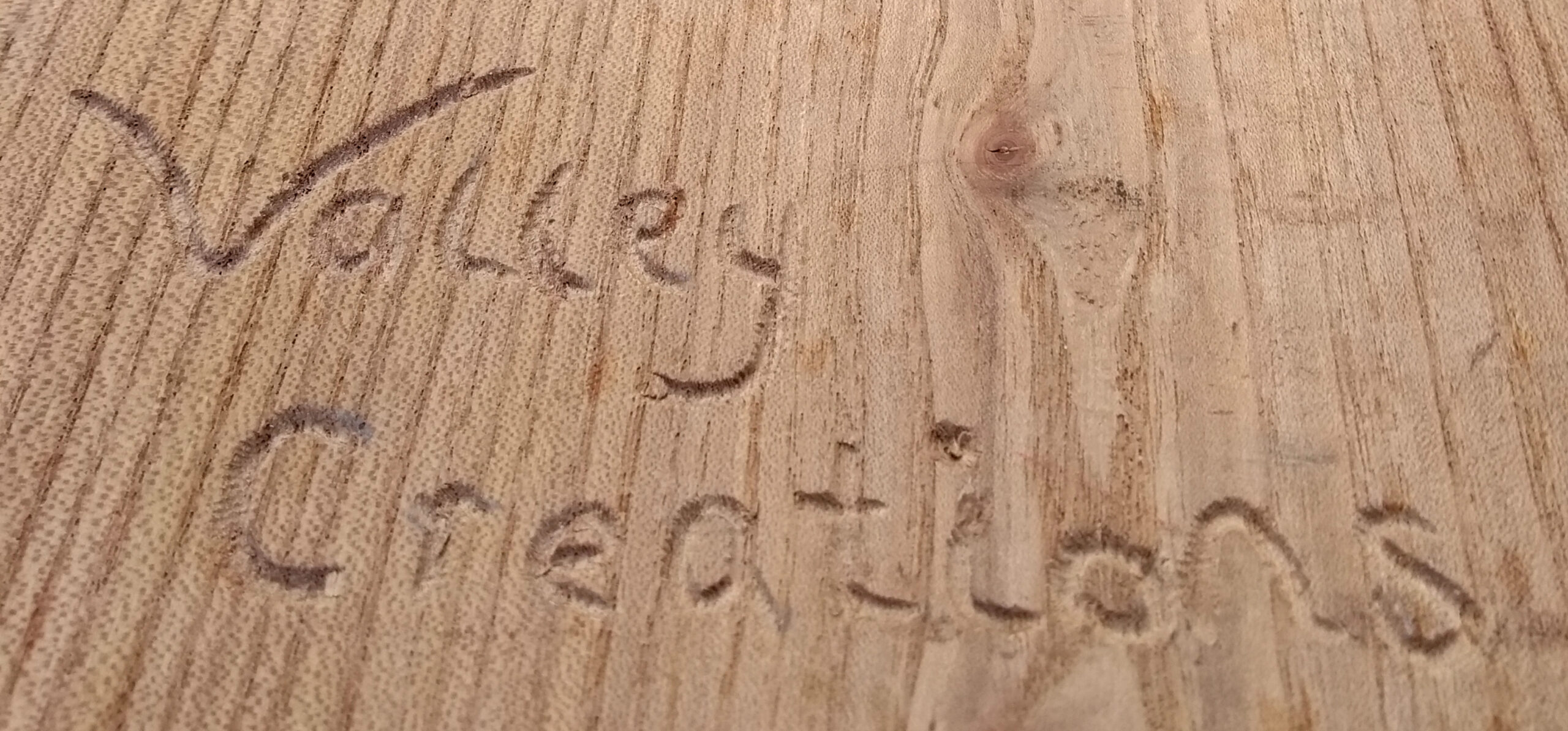 Our semi rural semi-detached has a flat section of garden at the back and then dips down the hillside at a crazy angle in every way. Beyond the end of the garden are fields and wonderful views in all directions. In the picture above, taken some years ago after Ruth had planted trees, dug and filled beds and I had built some paths and a shed, the bottom end of the garden goes down and sharply to the left out of picture until it reaches the level of the fields beyond. The smaller shed in the distance is in one of the gardens backing on to ours. We are very lucky to enjoy gardening, the challenge of solving design puzzles, views and wind. When Ruth moved in, it was neglected, used by various locals as a short cut to the fields below and the hillside bit was filled with sycamores. Over the years she has worked hard creating flower beds and earning enough money to fill them and to pay people to remove the sycamores, plant other native trees and hedging plants and build some serious steps down to the bottom, with a decking platform part way down and a pond near the bottom. Since I have moved in, I have added to that with, sheds, extra paths and steps to get to formerly almost unreachable parts of the garden, layed hedging, pollarded trees and added touches using green woodwork techniques. Apart from the early blitzing of the hillside to build the main steps and the platform, the garden evolves and, where possible, re-uses materials and plants. There are aspects of many Chelsea Flower Show gardens here, such as newly fashionable pollarded trees, artisan tools and work and even including the cow parsley that occurs naturally. In these pages I try to make this summary page reflect the garden shape in its most recent form, the second page covers the ancient history and each subsequent page follows on in time, so the last is the most recent.  Here is a picture from the same view in 2018, before the drought browned everything off. Trees have grown quite a bit, the huge lawn area is slowly being replaced with more beds and there is a pergola to lead the eye down the garden and give height. A greenhouse/shed is peeking out from behind my larger workshop shed. At the end of the flat area, there is a an arch to indicate that there is more to be seen. We have been letting the grass grow for the bees to get at the daisies and clover. Below is a quick tour round to give a further idea of the overall shape moving vaguely clockwise.   We’ll start the tour at the end of the garden visible in the pictures above. We are going down the steps just beyond the arch, after saying hello to the Owl sitting on the arch and carved from some of the sycamore from the lower garden.   An old picture of the top of the steps up towards where the arch now is. Those steps lead down to an even steeper set down to a platform.   The view to the platform. There are more steep steps below that and the garden goes down to trees at the end, beyond which you can see the fields. Below the platform, looking back up to the right is a set of access steps to get get back up and maintain that side.   To the left of the platform looking back up is a long path that eventually leads to some steps that curve back to a path across the widest part of the garden. Here the flat part of the garden is to our left and the first steps we went down are at the end of the woodchip path. The end of the path beyond that leads to the top of the access steps.   To the left of path across the wide part of the garden is a shelter for Green Woodwork and harvesting the trees in the garden. Hidden behind that is a path back through to the lawn and another through the trees to the formal vegetable plots behind the greenhouse. Hopefully that gives some idea of the shape and scale of the task. Other pages have more detailed pictures and story |
| 2018 This page might be a bit long and random as it is a catch up on gardening changes. The most recent being the extension of the shelter, together with a new wood chip path, lots of weeding and the application of a rotted manure mulch. We had to buy some of the wood chip in, but a lot comes from our own tree harvesting and the green woodwork     A while ago we added the middle bed below and that is developing nicely. We then added some beds in the big lawn circle and the central one has some lovely tulips and wild flowers   The raw sycamore used to make the rails on the patio is developng some interesting bracket fungus. The second picture shows just how dry the lawn became this year. Thank goodness for the colourful poppies.   At some point we had a visit by a couple of young foxes, who played in the garden for ages. I took a few videos and this is a still from one. The other picture shows the work of an industrious spider.   The same cornus tree at the beginning and end of the year. 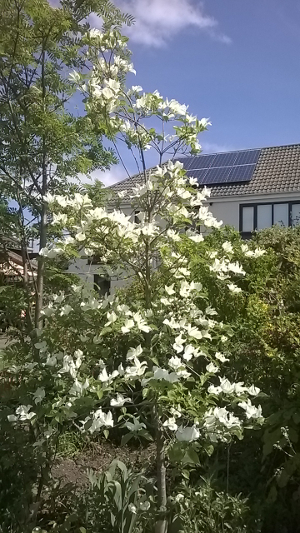  A couple of snow scenes.   Our resident pheasants in group dancing exercises and with offspring.  |
| 02/03/16 2015/16 This started as a blog but a change of mind on design and lack of application meant a change of tack. Winter, Pah! There have been floods in the valley below and I have been ill, so a slow going garden. The plants have not been sure what is happening and we have had temporary catkins and flowers all over the place. Still the snowdrops and daffodils are adding a bit of colour to the winter. I have got round to tidying up some of the bulk bags of soil I dug out for the shelter, relocated a turf pile and a leaf litter pile after some terracing work. We are still eating brussel sprouts and the last cabbage, but most stuff has gone allowing us to start preparing the beds. When I built the shelter below, I changed the design as I did it and so had two big fence posts left over, so I bought a couple more and produced the pergola opposite that seems to work well with the overall garden design.  16/10/15 Once again I have neglected the blog for other activities, so this is a bit of a catch up. At the end of the upper (flat) bit of garden there was a conifer, which was just one of several one or other of the neighbours have moaned about, even though they are not big by any standards. So this year is time to remove the conifer and the maple and tame a couple of others yet more. Here is the tree with some lower branches removed, revealing a sizeable space that couldn’t really be accessed before. .jpg) After sawing the tree down and digging out about 4 tons of earth room was made to build this shelter for wood chopping and chilling.  I used some spare decking to edge some more path down the hillside and at the same time cleared brash from a gap in the hedging and transplanted some seedlings. As you can see autumn is here, yet the buddleia on the right (which came from a pruned branch stuck into the garden) is still flowering.  It gives some idea of the scale of a garden like this when I found the partial telegraph pole in the detritus of the hedge, which I have never seen before in 8 years of clearing and organising the garden. 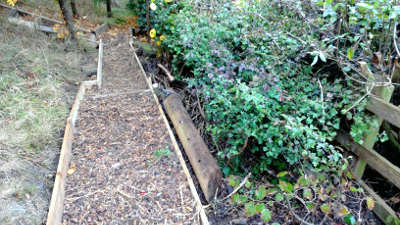 We also had the bathroom enlarged, so the old sink has been brought into use for pot cleaning.  Autumn has arrived giving us a colour treat.   And a rash of inedible or poisonous fungi.   Once the frosts come though we’ll be able to tuck into some more of Ruth’s produce.  13/8/15 Doesn’t time fly. You blink and a month goes by. Not that I haven’t been busy in the garden, Just not recording it. But my the bees are busy and a new tablet pc allows some better photos.   And the lavender looks stunning.   14/07/15 A few days away helping operate locks on a canal boat and I come back to a lot of fecund growth. Out this morning clearing some of it from a local cycle path and no energy left to attack the encroaching brambles again, so a few photos of more pleasant growth. Ruth seems to have a real knack of getting cuttings going from roses and we have even been transplanting full size plants with full success.   Then another friend gave me some blackcurrant cuttings as the latest of many such gifts and they are looking very inviting, as are the herbs ready to go with the potatoes, peas etc. that are now being delivered to me by Ruth. 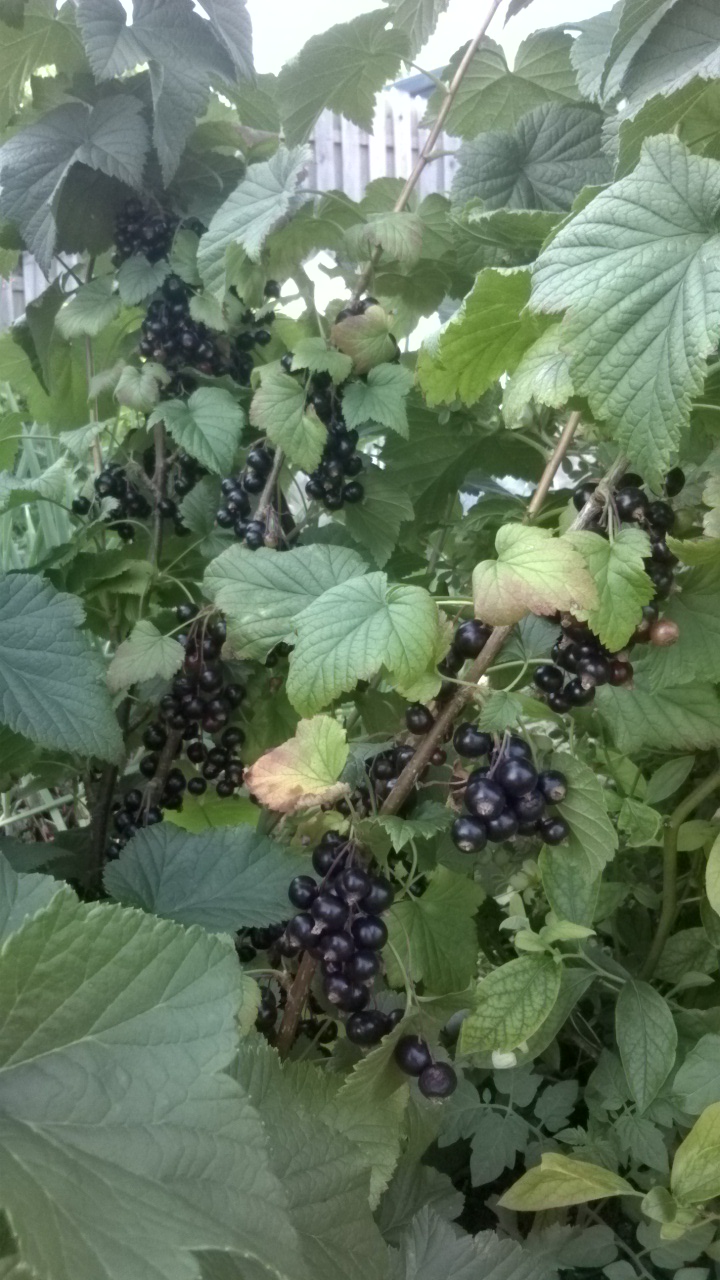  01/07/15 A new month and more weeding. After even a few minutes in this heat I was dripping and paused to take some photos. I tried over and over to capture some bees on the clover in the untamed lawn and always ended up with a blur. Perhaps another career as a wildlife photographer is not a good idea. This spider’s web enclosing a whole portion of plant was pretty impressive though. I think it was just copying Ruth’s brassica protection though (see below)  Anyway I feel so silly lying in various strange positions on my own lawn and the neighbours are starting to talk. Here is a bee on a more upright plant where I only have to bend down a bit.  30/06/15 A range of other activities and basic gardening tasks like hacking back the invading brambles from the school grounds next door, keeping stuff at bay from the various paths and not a lot that is interesting to report. When setting up these pages, I took a photo of the bed to the left of the main steps and it has changed with the season. The purple leaves at the back have bee overtaken by a cloud of flowers, the blue flowers have gone over and some at the front have come out. Plus an owl of course.  The bed on the other side of the steps now has some colour as the lavender starts and the mock orange sneaks out. The lawn clover is entertaining the bees too.  20/06/15 A few days away and the beginnings of a cold, so into the shed to finish a project that started last week – the top out piece for the arch.  And a bit closer  12/06/15 Not much gardening yesterday as Ruth was at work and then out at yoga and I was out inspecting the cycle paths and then tired. A quick shot of Ruth’s extreme brassica protection – no cabbage white’s here please! 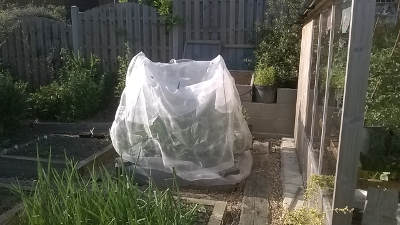 Today I decided to take advantage of the free electricity from the solar panels, using the mitre saw on the year before last’s wood, which is nicely dry ready to store in a shed. That will give me room for this year’s, which is filling all the other spaces. The big logs will need a bit more effort in splitting and cutting.  10/06/15 After the rigours of yesterday a bit of pottering. The beautiful yellow honeysuckle in the hedgerow has recovered from the laying process and is now coming into flower.  Up in the top garden these bulb Irises seem to be OK underneath the pollarded maple. Another variety is about to come out behind.  09/06/15 Finished an arch at the end of the lawn, indicating that there is more below the lawn horizon. I originally thought of a simple pergola, but realised I could probably make something of the thickest and longest sycamore branches waiting for firewood chopping or whatever. Two that were reasonably straight and two very bendy ones suggest an arch, so here goes. Four of those drive in Metposts, which I have never managed to drive in straight or far before, to seat the posts, bolts through the top and crude butt joints and it seems to do the job.  And the view from below with Ruth, who is moving tulips out and a shrub that struggled in a pot and some calendula in. Reviving plants and moving them to try elsewhere is a constant feature of a dry, windy and probably alkaline garden. I did buy Ruth a soil tester, but neither of us has used it. Though I have been gardening all my life, my knowledge is mainly vegetables and structures. As Ruth has suddenly developed a new found passion for vegetables, I have left that to her and may end up getting a wider plant knowledge.  05/06/15 A quick trip round the garden to see where brambles are growing now before fixing a guttering on the side of one of the sheds to send water into the retaining wall garden that holds up next doors house. Like most of our garden the flower bed there tends towards desert. I haven’t mentioned elsewhere that I built a set of steps in the middle of the garden as well, that enabled me to get down and start building the rest of the paths. Made out of old mill joists the view up them was looking stunning today and the wild geraniums at the top are even starting to bully the periwinkle.  Below the wood chopping area the foxgloves are coming out and looked good against the yellow of the broom that has managed to survive the bullying of the grass and the wind. 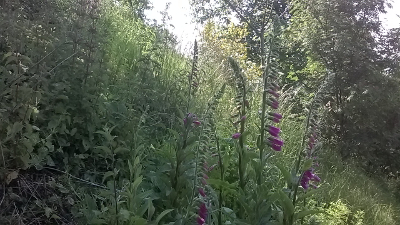 |
| 2013 With Ruth’s daughter Jessie living in New Zealand, I decided to do a few pictures of a day in the garden as we were having some work done to build a retaining wall and a base for the new greenhouse. The retaining wall holding up the fence and next door’s garden. Because our garden is so dry we have built water collection systems all over. These butts here are connected and collect from the other side of the shed as well. Where the pallet and barrow are was temporarily vegetable beds separated by the old sleepers and becomes the base for the greenhouse. The sleepers become the paths between the new raised vegetable beds, and the pallet becomes the bodgers bench by the way.  Ruth working on the flower beds. The bird feeding station sent seeds all over the garden there and the grey squirrels loved it so it was moved into the lawn and the upright post replaced with a slippery pole which seems to discourage them a bit. The red rose there is a great one that just flowers forever.  I was trying to work out ways of making paths to get at various bits of the garden that kept getting a bit neglected. These next two pictures shows some old mill joists laid down as a test out for a path running down from the vegetable beds, between the trees and then across below the circular lawn to meet another rough path across the top of the hill. Looking back to the retaining wall area. This path later became edged with some telegraph poles left over from building the platform nad with bark and wood chipping surface.  Looking down to the path from the lawn. This bit of path ended up edged with lots of bits left over from installing the fencing seen in the first picture and again bark and wood chipping surface.  This is what was a rough path across the top of the hill that later became more formalised as seen in the general tour of the garden and the artisan wood chopping area.  There is a pond somewhere under that marsh marigold and maybe even some lilies.  The maple tree had been recently pollarded – that seems to be in vogue at Chelsea too.  The decking patio was there, but the rails weren’t and I reduced the statuesque size of the bench when I installed the rails and a bigger parasol. The extension has now been rendered to match the house and the little bed now curves all the way from the acer across to the path in front of the shed. The light green tree sadly died. We think it just didn’t like the wind here.  The hedges were a little taller and each year became enmeshed with brambles from the school grounds – hopefully I’ll be able to control that better now.  The bits of left over fence that were used to edge paths later.  This bed opposite is shown in the garden tour page, but had just been planted by Ruth after an almost complete clear out. As in all gardens things change all the time as we experiment with different arrangements and time becomes available for more than just maintenance. The conifer hedge between us and the neighbours got aphid attacked one their side so we stripped down every other one and planted beech and similar hedging. We used the conifer trunks to attach a couple wire support lines and you can see one of those in the background. We’ll take the rest of the conifers out when the other hedging is a bit bigger and has thickened out.  |
| 2014/15 A busy couple of years. Ruth ended up working part-time and I gave up acting and building stage sets, so time suddenly became available. Platform Rails The ropes that hung between the posts of the platform had started rotting again so we decided to pollard the last remaining sycamore, that the platform is built round, and use some of the wood to make new barriers on the platform. The picture on the right shows the first experimental hurdle and one of the old ropes that has rotted and been attached to the top of the post rather than going through the hole and out the other side. The aim is to make the hurdle fit in the hole instead and then be attached with small brackets at the bottom.  Once the method had been tried it was just a matter of picking pieces of sycamore that fitted the various widths, cutting, peeling and shaping them on the bodgers bench with a draw knife, drilling holes to join them and then piece together and fit.  And ending up with a safer platform.  This uses the medium sized bits of branch, generates a lot of shavings that go on the paths and leaves other sizes for firewood or other uses.  Unfortunately I am not going to start making charcoal, so a lot of brash is generated that sits round the garden waiting for a use to be invented (other than as a wildlife habitat). 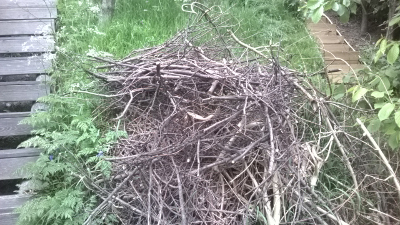 Hedging After the garden had been cleared, Ruth had some hedging planted down the sides, where there wasn’t already growth. This has grown and been trimmed over the years until my friend offered to help turn it into a laid hedge, which involves partially chopping through each trunk until what is left can be gently bent over at an angle of roughly 45 degrees (depending on the hedge style). Hopefully it still grows and also sprouts from the bottom where you have chopped through, creating a lower and much thicker hedge.  The hedge to the left of the platform from above before.  The hedge to the left after it has been laid. This is approximately a South of England style with stakes in the middle and the top bound with willow from the garden. The stakes were whatever could be got from the garden, because we haven’t been organised enough to have nice straight thick stakes yet. And after it has grown back a bit more. The Chelsea cow parsley seems to think it is a hedging plant too.  And the hedge on the other side looking up the garden.  The other hedge after laying. Running out of willow, so the style became a bit more casual.  In this one you can see how it has grown back, though there are still gaps as some grow slower and where in some places there weren’t enough trees to make a continuous line until the sprouts from the bottom grow.  The pond needs constant work and this year it has had to be cleared because the marsh marigold was choking it and the bottom side had to be raised because there was now around 2 foot of liner showing on the top side, The aim is to sort it out properly and get it to drain onto the feet of the gunnera. The hose pipe is connected to the overflow of a set of two water butts back up by the house.  |
